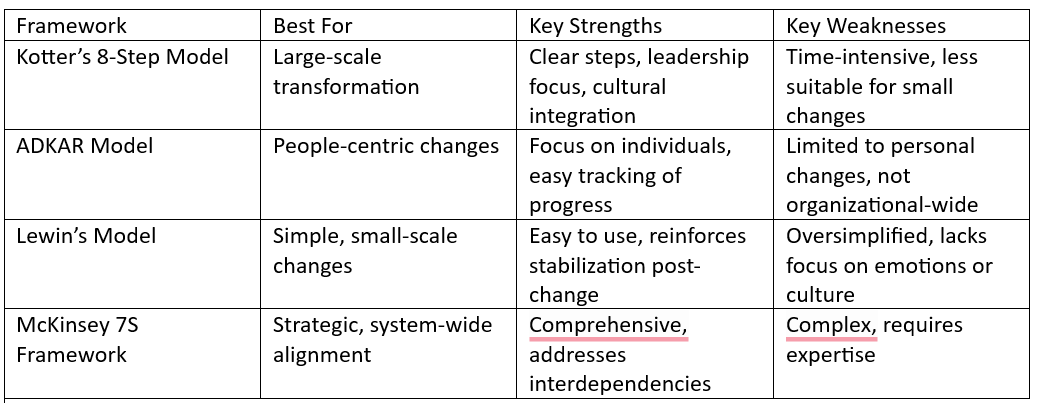Comparative Analysis of Popular Change Management Frameworks Change
Change management frameworks provide structured methodologies to manage organizational change effectively. Below is a comparative analysis of some of the most popular frameworks: Kotter's 8-Step Model, ADKAR, Lewin's Change Management Model, and The McKinsey 7S Framework. Each framework has unique strengths, making it more or less suitable depending on the organizational context and the type of change initiative.
1. Kotter's 8-Step Change Model
Overview: Developed by John Kotter, this model provides an 8-step process to lead organizational change, focusing on building urgency, a strong vision, and momentum through incremental steps.
Steps:
1. Create a sense of urgency.
2. Build a guiding coalition.
3. Develop a vision and strategy.
4. Communicate the vision.
5. Empower action by removing obstacles.
6. Create quick wins.
7. Build on the change.
8. Anchor the changes in organizational culture.
Best For: Large-scale transformation efforts requiring employee engagement.
Setting: Large corporations or multinational organizations undergoing mergers, restructuring, or digital transformation.
Strengths:
- Emphasizes urgency and long-term cultural integration.
- Focus on leadership coalition ensures broad support for change.
- Structured, clear steps make it easy to follow.
Weaknesses:
- Time-intensive.
- Less adaptable to smaller, incremental changes.
- May neglect technical or operational challenges.
2. ADKAR Model
Overview: Developed by Prosci, ADKAR focuses on individual change within an organization, addressing how people move through change at a personal level. The acronym stands for Awareness, Desire, Knowledge, Ability, and Reinforcement.
Steps:
1. Awareness of the need for change.
2. Desire to participate and support the change.
3. Knowledge of how to change.
4. Ability to implement required skills and behaviors.
5. Reinforcement to sustain the change.
Best For: Managing change in people-centric environments.
Setting: Medium-sized organizations, educational institutions, and HR departments introducing new tools or workflows.
Strengths:
- Focuses on individual engagement and adoption.
- Easy to integrate into broader frameworks.
- Allows for tracking progress at individual levels.
Weaknesses:
- Not a comprehensive organizational change framework.
- Relies heavily on robust leadership and communication efforts.
- Less applicable to rapid or large-scale changes.
3. Lewin's Change Management Model
Overview: Kurt Lewin's model outlines three simple stages: Unfreeze, Change, and Refreeze. It is widely used for its straightforward approach to managing transitions.
Steps:
1. Unfreeze: Prepare the organization for change by challenging the status quo.
2. Change: Implement the new processes, behaviors, or systems.
3. Refreeze: Reinforce and stabilize the new state to ensure sustainability.
Best For: Straightforward, short-term change projects.
Setting: Ideal for small businesses or departments introducing a new process or minor policy shifts.
Strengths:
- Simple and easy to understand.
- Focus on stabilizing post-change is often overlooked in other frameworks.
- Encourages thorough preparation before implementation.
Weaknesses:
- Oversimplified for large-scale or complex changes.
- Does not address emotional or cultural aspects of change in detail.
- Risk of rigidity in rapidly evolving environments.
4. McKinsey 7S Framework
Overview: This model analyzes seven key interdependent elements of an organization: Strategy, Structure, Systems, Shared Values, Skills, Style, and Staff. It focuses on alignment and interconnectivity during change.
Steps:
1. Assess the current state of the 7 elements.
2. Identify areas needing alignment.
3. Plan and implement changes across the elements.
4. Monitor alignment and progress.
Best For: Organizations seeking holistic, system-wide change.
Setting: Corporate environments facing strategic realignments, such as entering new markets or adopting new business models.
Strengths:
- Comprehensive approach addressing both hard and soft elements of change.
- Ensures alignment across all organizational dimensions.
- Can identify hidden resistance points.
Weaknesses:
- Complex and time-intensive.
- Requires substantial expertise to implement effectively.
- Does not explicitly address individual behavior change.
Selecting the appropriate change management framework depends on the organizational context, scope, and type of change initiative. Kotter's 8-Step Model is ideal for large-scale transformations requiring cultural shifts, while ADKAR excels in addressing individual behavioral change. For straightforward changes, Lewin's Model is a simple yet effective choice, whereas the McKinsey 7S Framework is best for complex, system-wide realignments. By understanding the unique attributes and applications of these frameworks, organizations can better tailor their approach to achieving successful, sustainable change.
Hope this helps.
Nicole








